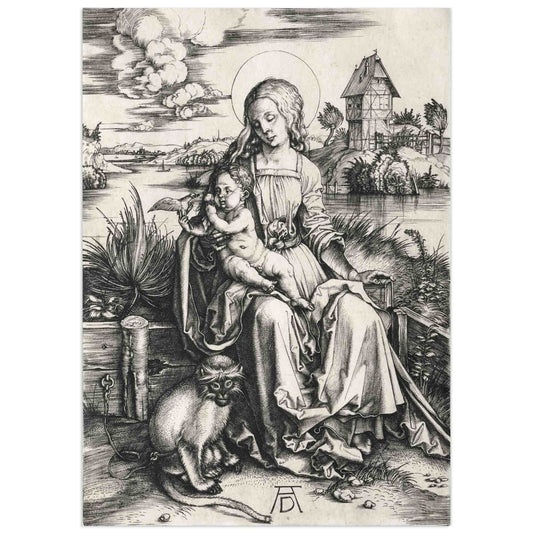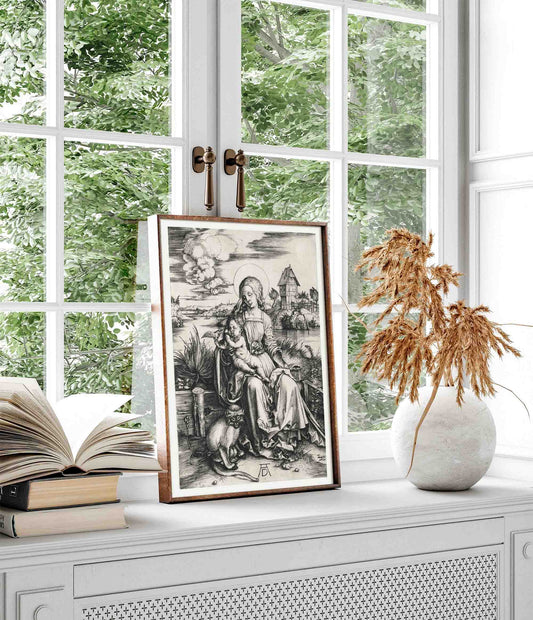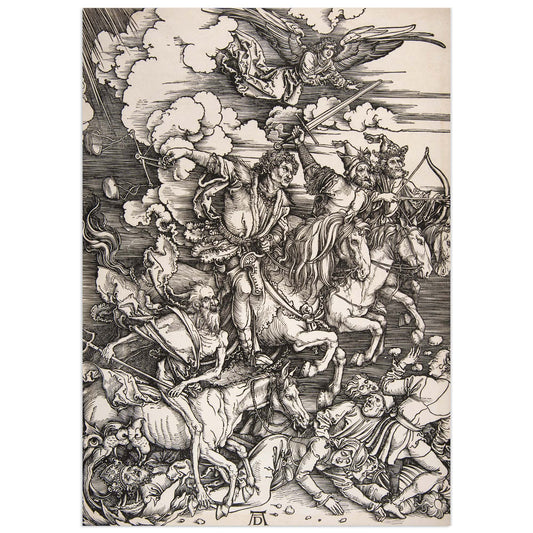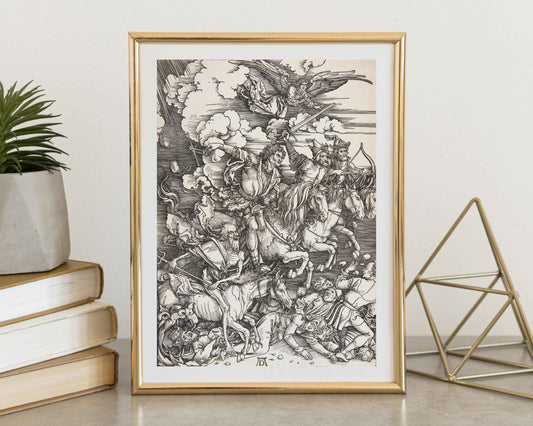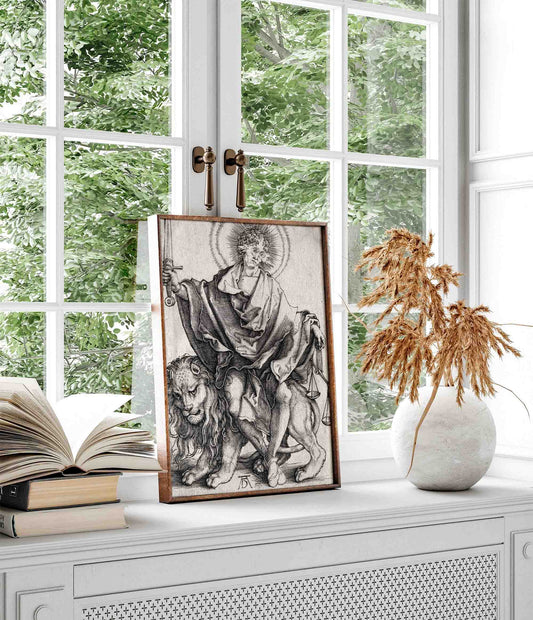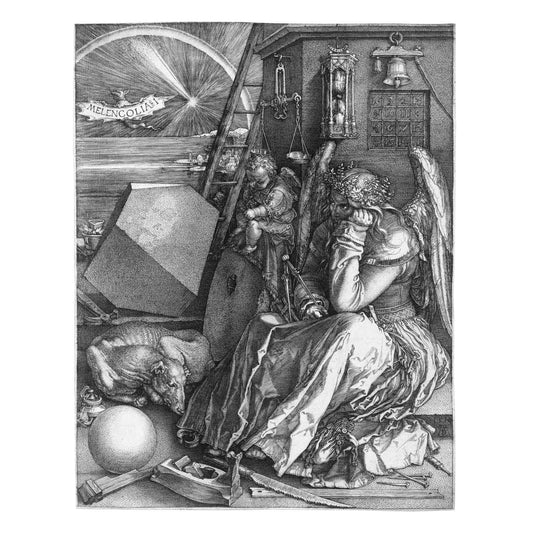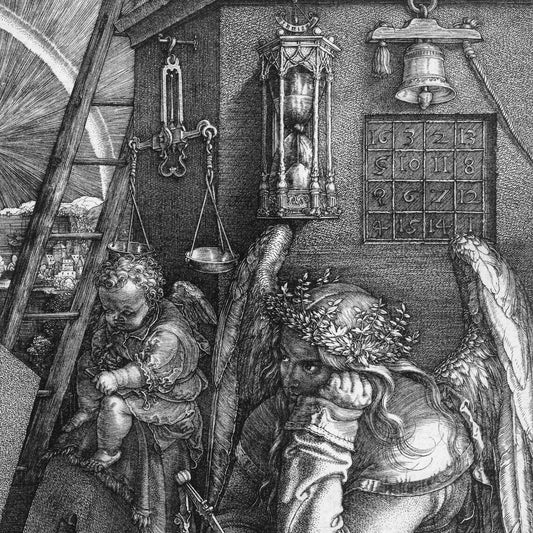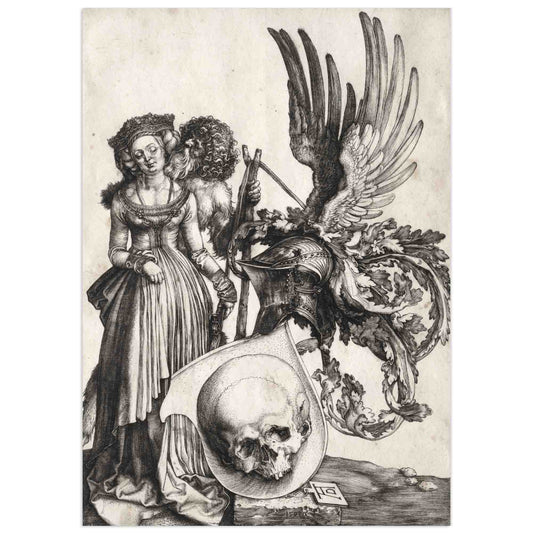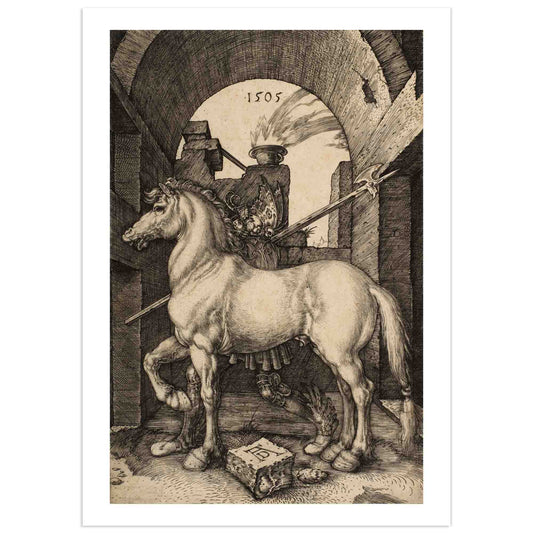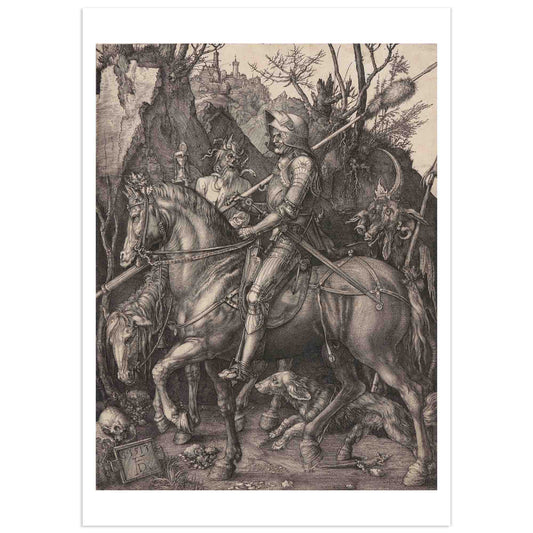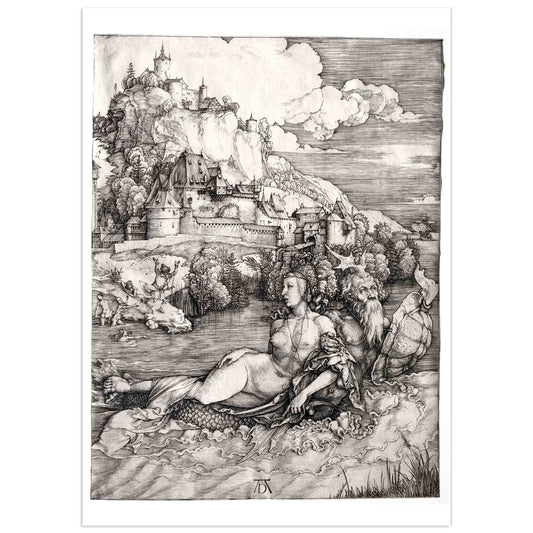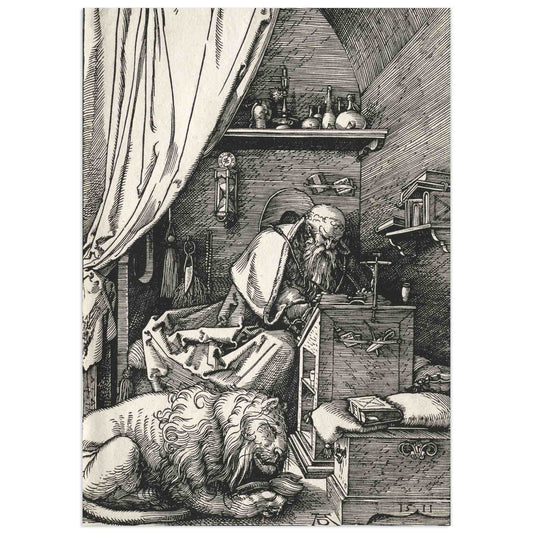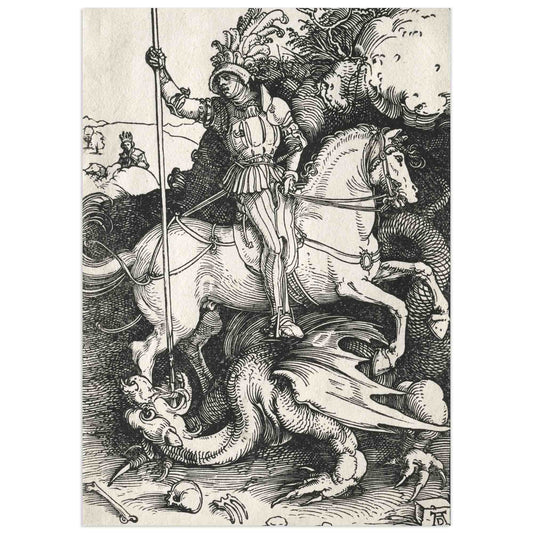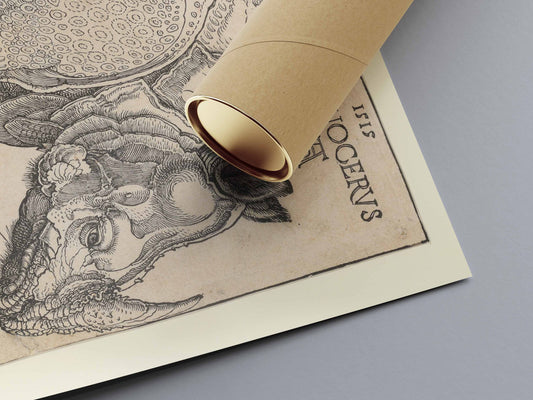Our collection features museum-quality reproductions of engravings and prints by the German master Albrecht Dürer, one of the most influential printmakers in the history of Western art. From his apocalyptic woodcut series to his intricate copper engravings, Dürer's printed works represent the pinnacle of Renaissance printmaking and remain as powerful and relevant today as when they were first created over five centuries ago.
Albrecht Dürer (1471-1528) was a painter, printmaker, and theorist from Nuremberg who transformed the art of engraving and woodcut into vehicles for complex artistic expression. His most celebrated engravings, including Knight, Death, and the Devil, Saint Jerome in his Study, and Melencolia I, demonstrate an unprecedented mastery of technique, symbolism, and compositional sophistication. These works established his reputation across Europe when he was still in his twenties and secured his position as the greatest printmaker of the Northern Renaissance.

What makes Dürer's engravings so remarkable is not merely their technical brilliance, but their intellectual depth. Each print is dense with symbolic meaning, reflecting Dürer's engagement with humanist philosophy, Christian theology, and the scientific knowledge of his time. His knowledge of Italian Renaissance artists combined with his immersion in German humanist circles allowed him to create works that bridged Northern European and Italian artistic traditions, introducing classical motifs and principles into Northern art while maintaining the meticulous detail characteristic of Germanic craftsmanship.
Our Wallango collection brings together Dürer's most famous engravings and woodcuts, printed with exceptional clarity to capture every line, every crosshatch, and every subtle gradation of tone that made these works revolutionary. Whether you're a collector of Renaissance art, a student of printmaking history, or simply someone who appreciates masterful draftsmanship, these Durer engravings offer a window into the mind of one of art history's greatest geniuses.
The Master Engravings: Dürer's Technical Pinnacle
Among Dürer's vast printed output, three copper engravings stand apart as his acknowledged masterpieces, often referred to collectively as the "Meisterstiche" or "Master Engravings." Created between 1513 and 1514, these works represent the absolute peak of engraving technique and conceptual complexity achieved during the Renaissance period.
Knight, Death, and the Devil from 1513 shows a mounted knight riding resolutely through a dark gorge, accompanied by two allegorical figures representing mortality and temptation. The knight, clad in elaborate armor rendered with astonishing precision, embodies Christian fortitude and the humanist ideal of virtuous determination in the face of life's trials. Every piece of the horse's tack, every link of chain mail, every texture of fur and scale is captured with microscopic accuracy through Dürer's mastery of the engraving burin. The print has been interpreted variously as an illustration of Erasmian Christian humanism, a meditation on the miles christianus (Christian soldier), or a more personal statement about the artist's own dedication to his calling.
Saint Jerome in his Study, created in 1514, presents a completely different mood. This serene interior scene shows the scholar-saint at work in a sun-filled chamber, accompanied by his symbolic lion and a sleeping dog. The play of light streaming through leaded windows, the careful rendering of every book, skull, and piece of furniture, and the profound sense of peaceful contemplation make this one of the most beloved images in printmaking history. Dürer's handling of perspective and architectural space demonstrates his theoretical knowledge of Italian Renaissance principles, while his attention to surface textures and symbolic details reflects Northern European traditions.
Melencolia I, also from 1514, is perhaps the most enigmatic and frequently analyzed image in the history of art. A winged figure, traditionally representing the melancholic temperament associated with artistic genius, sits in brooding contemplation surrounded by the tools of geometry, carpentry, and learning. A magic square, a polyhedron, a ladder, scales, an hourglass, and numerous other symbolic objects crowd the composition, each contributing to an overall sense of profound intellectual frustration. Art historians have proposed hundreds of interpretations, seeing in it everything from a self-portrait of artistic melancholy to a complex allegory of Renaissance Neoplatonic philosophy. What remains undisputed is the work's technical brilliance and its profound emotional and intellectual resonance.
Limited Edition Highlight
Don't miss our stunning reproduction of Melencolia I in a luxury limited edition of only 20 numbered prints on premium Ilford Cotton Textured 310gsm paper. Each print includes a certificate of authenticity.
View Limited Edition →These three Albrecht Durer most famous engravings showcase different facets of his genius: dynamic action and moral allegory in the Knight, contemplative serenity and mastery of interior space in Saint Jerome, and dense symbolism combined with emotional intensity in Melencolia. Our reproductions capture the remarkable tonal range Dürer achieved through his engraving technique, from the deepest blacks to the most delicate grays.
The Apocalypse Woodcuts: Revolutionary Narrative Art
In 1498, when Dürer was just 27 years old, he published a complete illustrated edition of the Book of Revelation that would revolutionize the woodcut medium and establish his international reputation. The Apocalypse series consists of fifteen large-format woodcuts that bring the visionary text of Saint John to life with unprecedented dramatic power and technical sophistication.
Before Dürer, woodcuts were generally considered a cheaper, less refined alternative to engravings, suitable for popular religious imagery and book illustration but not for serious artistic expression. Dürer transformed the medium, demonstrating that woodcuts could achieve effects of drama, movement, and compositional complexity equal to any other artistic technique. He worked closely with skilled block cutters to translate his designs into wood with extraordinary precision, creating prints that featured intricate crosshatching, dynamic figure groups, and complex spatial arrangements previously thought impossible in the medium.
The most famous image from the series is the Four Horsemen of the Apocalypse, a composition of stunning visual power. The four riders surge across the picture plane from left to right, trampling victims beneath their horses' hooves in a scene of terrifying divine judgment. The sense of movement, the intricate rendering of the horses and riders, and the dramatic energy of the composition make this one of the most iconic images in Western art. The technical achievement is remarkable: Dürer created convincing depth, volume, and texture using only black lines carved in relief on wooden blocks.
Other notable prints from the Apocalypse series include Saint Michael Fighting the Dragon, which shows the archangel and his forces battling a seven-headed monster with extraordinary dynamism, and The Opening of the Fifth and Sixth Seals, featuring multiple episodes arranged in a complex vertical composition that draws the eye upward from earthly destruction to heavenly glory.
The Apocalypse woodcuts appeared at a moment of millennial anxiety at the end of the fifteenth century, when many believed the end times prophesied in Revelation were imminent. Dürer's images gave powerful visual form to these fears and hopes, and the prints circulated widely throughout Europe, spreading his fame and demonstrating to artists everywhere the expressive potential of the woodcut medium.
Our collection includes the major images from this groundbreaking series, allowing you to experience the full force of Dürer's apocalyptic vision. These Albrecht Durer apocalypse prints remain as compelling today as they were over five centuries ago, their combination of technical mastery and emotional intensity undiminished by time.
Religious Engravings and Devotional Prints
Beyond the Master Engravings and the Apocalypse series, Dürer produced an extensive body of religious prints that served both devotional and artistic purposes. These works range from intimate depictions of the Virgin and Child to dramatic scenes from Christ's Passion, each demonstrating his ability to infuse traditional Christian iconography with fresh psychological depth and technical innovation.
The Adoration of the Magi engraving showcases Dürer's ability to handle complex multi-figure compositions. The three kings present their gifts to the infant Christ in a ruined classical building, a setting that allowed Dürer to display his knowledge of architectural perspective and his interest in antique forms. The elaborate costumes of the Magi, rendered with typical Dürer precision, reflect contemporary German taste for exotic luxury while also serving as symbols of the different ages of man and the three known continents paying homage to Christ.
His various depictions of the Virgin Mary demonstrate his range and sensitivity. From intimate domestic scenes to more formal iconic presentations, Dürer explored different aspects of Marian devotion. The Virgin and Child with a Monkey introduces a curious symbolic element, with the chained primate possibly representing sin restrained by Christian grace. The attention Dürer pays to the Virgin's drapery, the Christ child's anatomy, and the various symbolic details creates images that work both as objects of private devotion and as demonstrations of artistic virtuosity.
The Passion of Christ occupied Dürer throughout his career, resulting in multiple series in different media. His engravings of the Crucifixion, the Agony in the Garden, and other Passion scenes combine profound emotional engagement with the suffering of Christ with sophisticated compositional arrangements. Unlike some of his Northern European predecessors, who emphasized graphic suffering, Dürer balanced pathos with dignity, creating images that are moving without being merely gruesome.
Other significant religious engravings include his depictions of various saints, particularly Saint Christopher, Saint Eustace, and Saint Anthony, each rich with symbolic attributes and narrative detail. These prints served the devotional needs of contemporary Christians while also functioning as collectible works of art appreciated for their technical excellence and aesthetic qualities.
Portraits and Studies from Life
While Dürer is primarily celebrated for his allegorical and religious engravings, his portrait prints reveal another dimension of his artistic personality. These works demonstrate his ability to capture individual character and psychological presence through the linear medium of engraving, translating the immediacy of drawn or painted portraits into the more formal language of printmaking.
His engraved self-portraits show the artist at different stages of his career, always with penetrating self-awareness. Unlike his painted self-portraits, which often present an idealized image, his printed self-images tend to be more informal and direct, showing Dürer as a working artist rather than as a gentleman-scholar.
Portrait engravings of his contemporaries include images of humanist scholars, fellow artists, and other notable figures. These works often include elaborate framing devices, inscriptions, and symbolic elements that provide context about the sitter's achievements and character. The portrait of Philipp Melanchthon, Martin Luther's close associate, shows Dürer's engagement with the Protestant Reformation that transformed Germany during his lifetime.
Beyond formal portraits, Dürer produced numerous studies of human heads, hands, and figures that served both as technical exercises and as explorations of human variety and expression. His study of hands in various positions demonstrates his fascination with anatomy and gesture, while his depictions of peasants and common people show his interest in character types beyond the educated elite who typically commissioned portraits.
These portrait engravings and figure studies reveal Dürer's fundamental belief, articulated in his theoretical writings, that the proper study of art begins with careful observation of nature. Whether depicting himself, his patrons, or anonymous models, Dürer approached each subject with the same combination of technical rigor and psychological curiosity that characterizes all his work.
Allegorical and Mythological Prints
Dürer's engagement with classical mythology and allegorical subject matter reflects the humanist intellectual culture of Renaissance Europe. These prints demonstrate his ability to adapt Italian Renaissance themes to Northern European artistic traditions, creating works that are both classically informed and distinctively Germanic in their detailed execution.
The Fall of Man (also known as Adam and Eve), created in 1504, represents Dürer's most ambitious attempt to depict the ideal human figure according to classical proportions. The first human pair stands in carefully calculated contrapposto poses, their bodies conforming to mathematical ratios derived from ancient sculpture and Italian Renaissance theory. Yet the print is filled with Northern European symbolic details: the animals representing the four temperaments, the parrot symbolizing the Virgin Mary, the mountain ash tree associated with life, and the fig tree linked to sin and sexuality. This combination of Italian formal principles with Northern symbolic complexity exemplifies Dürer's synthetic approach.
Nemesis (The Great Fortune), a large engraving from around 1501-1502, shows a winged female figure standing on a sphere above a detailed landscape. This personification of divine retribution or fortune demonstrates Dürer's ability to create convincing monumentality in a small-scale print, as well as his interest in allegorical complexity. The figure's powerful anatomy, the vertiginous aerial perspective, and the meticulously rendered landscape below create a composition of remarkable visual and conceptual ambition.
Other mythological and allegorical subjects include The Sea Monster, showing the abduction of a nude woman on a sea creature in a scene of mysterious narrative content, and various depictions of classical themes filtered through medieval interpretive traditions. These works allowed Dürer to explore themes of fate, virtue, love, and human nature through the symbolic language inherited from classical antiquity but adapted to contemporary concerns.
What distinguishes Dürer's approach to classical and allegorical subject matter is his insistence on giving even abstract concepts concrete visual form grounded in observed reality. His allegorical figures are anatomically convincing, his mythological creatures are rendered with the same attention to detail as his natural history studies, and his symbolic objects are depicted with technical precision. This combination of intellectual abstraction with visual concreteness creates prints that work on multiple levels, satisfying both the educated viewer who can decode their symbolism and the general viewer who can appreciate their formal qualities.
Technical Innovation and Influence
Dürer's importance in the history of printmaking extends beyond the individual quality of his prints to his role in advancing the technical and conceptual possibilities of the medium. His engravings demonstrate an unprecedented control of the burin, the engraver's primary tool, allowing him to create effects of tone, texture, and depth that earlier printmakers had struggled to achieve.
His development of sophisticated systems of crosshatching, the use of varying line weights to suggest form and space, and his ability to create convincing textures from fur to metal to flesh revolutionized what could be accomplished in the engraving medium. Later printmakers studied his techniques intensively, and his influence can be traced through centuries of European printmaking.
In woodcut, Dürer elevated what had been primarily a reproductive and popular medium to the status of high art. His collaboration with skilled block cutters produced prints of unprecedented refinement, demonstrating that woodcuts could achieve expressive effects and technical sophistication comparable to engravings. This transformation of the medium had profound implications for book illustration and independent printmaking throughout the sixteenth century and beyond.
Dürer was also innovative in the commercial aspects of printmaking. He established a workshop that produced and distributed his prints throughout Europe, creating an international market for reproductive art. His practice of signing and dating his prints, and of using his distinctive monogram as a kind of brand identity, helped establish printmaking as a legitimate form of artistic expression rather than merely a craft activity.
His theoretical writings on proportion, perspective, and geometry, published in various treatises during his later years, codified much of the knowledge that informed his artistic practice. These texts influenced generations of artists and helped establish the intellectual credentials of printmaking and visual art more generally.
The influence of Durer engravings on subsequent art history is difficult to overstate. Artists from Rembrandt to Goya to Picasso studied and learned from his prints. His technical innovations became standard practice, his compositional strategies were widely imitated, and his approach to symbolic content influenced how artists thought about meaning in visual art. Even today, nearly five hundred years after his death, Dürer's engravings remain touchstones for technical excellence and conceptual depth in printmaking.
Collecting and Displaying Dürer Engravings
Dürer's engravings have been prized by collectors since the artist's own lifetime, and the tradition of collecting his prints continues today. While original impressions from Dürer's time are rare and extremely valuable, residing primarily in major museum collections, high-quality reproductions allow contemporary art lovers to experience and live with these masterworks.
Our Wallango reproductions are created using advanced printing technology that captures the full tonal range and precise line work of Dürer's engravings. Each print is produced on museum-quality paper using archival inks that ensure longevity and color stability. The result is a reproduction that honors the original's technical qualities while being affordable and accessible.
Dürer's engravings work beautifully in a variety of interior settings. Their linear quality and generally monochromatic palette make them adaptable to both traditional and contemporary decor. A grouping of related prints, such as several images from the Apocalypse series or the three Master Engravings displayed together, can create a dramatic focal point in a study, library, or living area. Individual prints work well in more intimate spaces, inviting close viewing and contemplation of their intricate details.
The intellectual depth and symbolic complexity of Dürer's prints make them particularly appropriate for scholarly or professional environments. They suggest cultivation and learning while also demonstrating appreciation for supreme technical craftsmanship. In educational settings, they serve as excellent teaching tools for discussions of Renaissance art, printmaking techniques, or the intersection of art and ideas.
For those interested in the full range of Dürer's artistic achievement beyond his engravings, explore our collection of Albrecht Dürer oil paintings and watercolors , where you'll discover his pioneering landscape watercolors, detailed nature studies, and powerful portrait paintings.
Why Choose Wallango for Your Dürer Prints
When you select Albrecht Durer art from Wallango, you're choosing reproductions that have been carefully prepared to maintain the integrity of these historic masterworks. We understand that the clarity of line, the subtlety of tone, and the precision of detail that characterize Dürer's engravings require exceptional printing quality.
Each print in our collection is produced using state-of-the-art digital printing technology on acid-free, archival-quality paper. We've carefully color-matched and calibrated our reproductions to capture the warm tonality of historical prints while maintaining the sharp definition that makes Dürer's line work so remarkable. The result is a print that conveys the aesthetic experience of viewing an original engraving while being far more accessible and affordable.
Our selection includes Dürer's most celebrated engravings as well as lesser-known works that demonstrate the full range of his printmaking genius. Whether you're drawn to the dramatic power of the Apocalypse series, the intellectual complexity of the Master Engravings, the devotional intimacy of his religious prints, or the technical virtuosity of his portrait engravings, you'll find museum-quality reproductions that bring these Renaissance masterpieces into your space.
Frequently Asked Questions About Dürer's Engravings
What is Albrecht Dürer's most famous engraving?
Albrecht Dürer's most famous engraving is arguably Melencolia I from 1514, one of his three "Master Engravings." This enigmatic image of a brooding winged figure surrounded by symbolic objects has fascinated viewers and scholars for centuries and remains one of the most analyzed images in art history. The Knight, Death, and the Devil (1513) and Saint Jerome in his Study (1514), the other two Master Engravings, are nearly as famous and equally important to Dürer's reputation. Among his woodcuts, the Four Horsemen of the Apocalypse from his 1498 Apocalypse series is probably his single most iconic image.
What technique did Dürer use for his prints?
Dürer worked primarily in two printmaking techniques: engraving and woodcut. For engravings, he used a burin to incise lines directly into copper plates, which were then inked and printed on paper. This technique allowed for extremely fine detail and subtle tonal variations through crosshatching. For woodcuts, Dürer drew his designs on wooden blocks, which were then carved away by skilled craftsmen, leaving the image in relief to be inked and printed. Both techniques were used in Dürer's time, but he elevated each to unprecedented levels of sophistication and expressive power.
Where can I buy Dürer engraving reproductions?
High-quality reproductions of Dürer's engravings and woodcuts are available here at Wallango. Our collection includes his most famous works including the Master Engravings, the Apocalypse series, and numerous other religious, allegorical, and portrait prints. Each reproduction is printed with careful attention to capturing the precise line work and tonal qualities that make Dürer's engravings so remarkable. All prints are produced on archival paper with museum-quality inks to ensure longevity.
Why are Dürer's engravings so important?
Dürer's engravings are important for multiple reasons. Technically, they represent the highest achievement in engraving during the Renaissance period, demonstrating unprecedented control of the medium and expanding its expressive possibilities. Artistically, they combine supreme draftsmanship with complex symbolism and intellectual depth, making them works of both visual beauty and conceptual sophistication. Historically, they helped establish printmaking as a legitimate art form rather than merely a reproductive craft, and they spread Dürer's influence and Northern Renaissance artistic principles throughout Europe. Their combination of technical brilliance, aesthetic power, and intellectual complexity has made them objects of study and admiration for nearly five hundred years.
How did Dürer sign his engravings?
Dürer signed his engravings with his distinctive monogram: the letter 'A' with a larger 'D' inside it, creating an instantly recognizable signature that functioned as both artistic signature and commercial brand. He typically included this monogram prominently on his prints, often along with the date of creation. This practice of signing and dating prints was relatively innovative at the time and helped establish the identity of individual impressions and reinforced Dürer's authorship and reputation. The monogram became one of the most famous artist's marks in history and has been widely imitated and referenced by later artists.
What is the Apocalypse series?
The Apocalypse is a series of fifteen large woodcuts illustrating the Book of Revelation, published by Dürer in 1498 when he was just 27 years old. This was a complete illustrated book that included both the biblical text and Dürer's dramatic visual interpretations of Saint John's visions. The series includes iconic images such as the Four Horsemen of the Apocalypse, Saint Michael Fighting the Dragon, and the Whore of Babylon. These prints revolutionized the woodcut medium, demonstrating that it could achieve effects of drama, complexity, and technical sophistication equal to engraving. The Apocalypse series established Dürer's international reputation and remains one of the most important achievements in the history of printmaking.
Browse our complete collection of Albrecht Dürer engravings and woodcuts to discover why this German Renaissance master remains one of the most influential printmakers in the history of Western art. From the apocalyptic drama of his early woodcuts to the technical perfection and symbolic depth of his mature engravings, Dürer's printed works offer inexhaustible rewards for careful viewing and contemplation. Whether you're a serious collector, a student of art history, or simply someone who appreciates masterful craftsmanship and profound artistic vision, these prints belong in spaces dedicated to beauty, learning, and the enduring power of great art.

